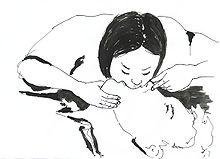
Cardiopulmonary resuscitation
What is Cardiopulmonary Resuscitation??????????
Is an emergency emergency operation carried out by the medic and performed manually in an attempt to maintain healthy brain functions until further measures are taken to restore spontaneous blood circulation and respiration to save the life of a person with a heart attack, the patient undergoing cardiac resuscitation is considered to be in clinical death, The recovery process is not immediately initiated, and the brain cells begin to develop irreversible damage within minutes (10 minutes).
.............................................................................................................................
Primary recovery steps [edit]
Make sure you and the patient are safe and safe from hazards.
Test the patient's reactions, make sure the patient's condition is answering the call, shaking, or is he overwhelmed by it?
If the patient does not respond:
Ask for help (call the ambulance, call for help or assistance)
Turn the patient over the back, open the respiratory tract by extending the neck (press on the forehead and lift the jaw up). If the patient is suspected of breaking the neck, the jaw should be lifted up only without pressing the forehead.
If the patient is breathing normally (do not be fooled if you see a spasmodic breath, people with a heart attack usually breathe irregularly. This intermittent breathing is not considered a normal breathing and does not change the fact that the patient has a heart attack and needs immediate recovery!)
If the patient is breathing regularly, turn it over to the lateral stabilization position, so that if the patient vomits, the respiratory tract will not close (vomit)
If the patient does not breathe regularly regular breathing:

Natural breathing examination
In the 19th century, Dr. Silvestre described a method of industrial ventilation where the patient lay on his back with his arms raised above their head to help the sensation and then pressed on their chest to help exhalation. [12] The procedure is repeated sixteen times per minute. This method can be seen in many of the films that appeared in the early 20th century.
A second technique, called the Holger Nielsen technique, was described in the first edition of the Scouting Boy's Handbook in the United States in 1911. This method was purified in the 1950s (used in one of the episodes of the famous television series "Lacey" in the mid-1950s Of the last century) and sometimes used as a comedy effect in animation programs at the time as in one of the episodes of Tom and Jerry entitled "The Cat and the Mermouse" in 1949. This method continues, for historical purposes, along with the modern cardiac pulmonary resuscitation Book Boy Scouts until 1979. This technique was later banned Of first aid manuals in the United Kingdom.

Oral resuscitation to the affected person's mouth
Hi. I am a volunteer bot for @resteembot that upvoted you.
Your post was chosen at random, as part of the advertisment campaign for @resteembot.
@resteembot is meant to help minnows get noticed by re-steeming their posts
To use the bot, one must follow it for at least 3 hours, and then make a transaction where the memo is the url of the post.
If you want to learn more - read the introduction post of @resteembot.
If you want help spread the word - read the advertisment program post.
Steem ON!
Downvoting a post can decrease pending rewards and make it less visible. Common reasons:
Submit